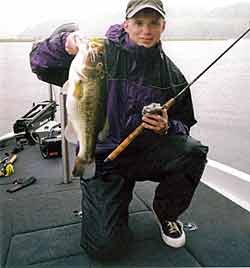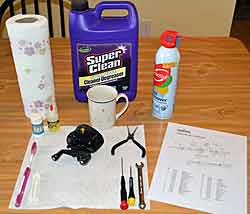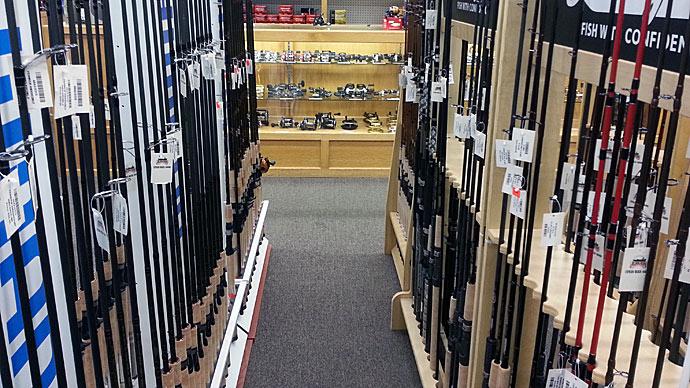
I will admit it. I moved from New York to North Carolina 10 years ago to fish more. Yes, New York has fantastic fishing, but it is limited. From about mid-October until late March every year, my boat was parked inside, hibernating while the cold winds blew and the lakes and rivers were covered with ice.
I’ve never stored my boat since I became a Tar Heel. I fished my first tournament here in December and the second in January. I now fish year-round through frozen rod lockers, blazing sun, and high humidity. That’s great, but there are days when I miss fishing up north. The smallmouth fisheries there are unmatched; every lake has grass, and those months of unmolested life under the ice encourage bass to keep biting all summer and straight through fall.
But even with all those pluses, you still have to deal with one giant minus — making your way through the long winter. It’s a struggle faced by bass anglers across the northern stretches of the country. Ice fishing can bring some distraction, but I don’t know too many bass anglers who fully embrace it. So what do you do if ice and snow keep you off your favorite bass lakes for a few months? Luckily, there are many ways to stay on top of your fishing game and prepare for the upcoming season. Here are 10 of them:
Map study

Map study is still essential today when GPS unites grace the deck and console of almost every boat. So on a snowy Saturday, pour yourself a second cup of coffee and spread maps of your favorite lakes across the kitchen or dining room table. Paper maps give you perspective. Instead of zeroing in on a tiny spot — or zooming out and leaving detail behind — on your GPS, paper maps let you see entire sections of the lake with the same level of detail. You’ll see how shallow spawning flats intersect with deep wintering areas or how river channels intersect and twist to form flats that may be a little deeper than you usually fish.
Try looking at paper maps from different directions. They are designed so north is at the top, and that’s the way most anglers look at them. Try spinning it 180 degrees, looking from north to south. You’ll see what looks like an entirely different lake, and structure that your eyes have become numb to will appear. If the wind almost always blows from the northwest on your lake, turn the map so that direction is pointing away from you. You might find some sheltered spots, or better yet, ones that receive the wind that you haven’t fished before.
Another trick is highlighting specific contours with a marker. If they are on your map, try the 10-foot and 30-foot lines. The shallower line will show spring spawning flats and other shallow-water structure. This will make underwater flats and points jump off the map. The deeper line will eliminate a lot of water because, for the most part, you’ll rarely fish deeper than that. If you fish in a reservoir, you can do the same for river and creek channels.
Rebuild your reels

Yes, there are many parts inside your reels, but with some patience and planning, you can take them apart, lube them, and put them back together — with no parts left over. Your reels will last longer and perform better with regular maintenance. That can be a simple disassembly. When you remove the cover, put a drop or two of oil on the bearings and maybe wipe some grease on the gears and level-wind drive. Or it can be a total rebuild when you disassemble the entire reel, clean the bearings in parts wash, and then reassemble with fresh grease and oil.
The first thing you’ll need — unless you have a photographic memory — is the parts schematic for the reel. It’s no problem if you don’t have the copy that came with the reel. Google the make and model, and you’ll find one to print or pull up on your smartphone or tablet. It will also give you part numbers if you need to replace one.
You’ll need a few tools: some small screwdrivers, needle-nose pliers, and a box-end wrench to remove the handle nut. Cotton swabs are great for removing old grease from nooks. An old toothbrush will clean gear teeth, and you can use paper towels to wipe clean other parts. As you disassemble a reel, lay out the parts in the order, and they are removed. That will help with reassembly. Keep an eye out for thin washers that are used as spacers. Not much thicker than a piece of paper, they are easily lost while cleaning another part. There seems to be more of them in spinning reels. It also is better to work over a hard floor because carpet swallows small parts.
Wash the bearings with parts cleaner in an old ceramic coffee mug. After they are clean, use a can of compressed air, such as what is used to clean computers and electronics, to blow out any residual wash. Once all the parts are clean, you can start the reassembly process. Choose quality grease and oil designed for fishing reels. Invest in some high-end lubricants and super-tuned bearings if you want to go further with your tune-up. They’ll help your reels cast farther.
Don’t forget your rods.
Rods typically don’t receive much attention unless they are broken in two. But they do a lot of work during the season and need a checkup. Run a cotton swab around the inside of the guides. Any nicks that could cut your line will catch the cotton. Make sure the tip eye is securely attached. If it isn’t, use a touch of heat-sensitive glue to reattach it. Furniture polish will help keep the blank looking new. Are the cork handles dirty? Run them under warm water while scrubbing with the abrasive side of a kitchen sponge loaded with dishwashing soap. If handles feel rough, run some fine sandpaper over them.
Practice casting
I made many Bassmaster Classic winning pitches in my driveway from a snowbank when I was young. Or at least I thought that’s what they were. My time there translated to better casting and pitching accuracy at greater distances when I finally found open water. Set up a target outside and start practicing with your favorite combo or the one you received as a holiday gift. The best lure to practice is a jig or spinnerbait with the hook cut off. Hookless crankbaits aren’t a bad choice, either. Set targets at different distances and angles. Overhanging tree limbs add difficulty. The practice will be even more effective if you’re standing at the same height above the ground as above the water while on your boat.
Before you hit the water, be sure to change the line. Nothing will nick it up faster than being dragged across your driveway or yard. And, after all that practice, you don’t want it to give out when you make that perfect pitch and feel a bass strike.
Watch fishing shows
Snow-bound anglers have been passing the time with fishing shows since they first aired. I used to record them and watch them again — and again — during the week. Fishing shows bring bad and good. Edited to maximize fish catches, they can add to the frustration felt by anglers desperate to feel a bite. But in between the hook sets, take note of the subtle lessons. They can include how a boat or a lure is rigged—for example, the way “In-Fisherman” Editor in Chief Doug Stange rigs his swimbaits. Instead of vertically driving the hook through the narrow side, he rigs them, so the hook comes through the wider side. I’ve watched him do this for several seasons and explain that it adds more action. I’m giving that a try.
Thanks to today’s high-tech world, you’ll find more fishing shows and how-to videos online at Bassresource.com. Anglers worldwide post videos to share tactics and techniques in full detail. You also can find early Bassmaster tournaments and even tours of lakes and rivers. That’s a great way to jump on the new lake you plan to fish this season. Best of all, they are on demand.
Attend an outdoor show
Outdoor shows are held in cities across the country. They are where manufacturers, guides, and tackle shops display their goods and services for anglers to check out and purchase. It’s a great place to drool over a new bass boat, even if it isn’t in your budget, and commiserate with other anglers. Often local experts and national touring professionals give seminars, sharing bass-catching tips. And if you have a nasty case of the winter blues, most shows have a trout pool where you — err, children — can wet a line.
Tune lures
During the winter, you have plenty of time to organize and tune your lures. After an entire season of use, many old lures need a refreshing, and new ones need to be made water ready. Jigs fall into that second category. You can trim their skirts — the shorter you go, the more they flair in the water — trim weedguards — thinning them and then splitting them into a V-shape. That keeps the snag protection and gives the hook a clean shot. You also can give your spinnerbaits some attention, swapping blades or the skirt. Leave plastic trailers off till you’re on the water. They tend to gum up skirts and blades when rigged and stored for any length of time.
You can’t tune crankbaits when you don’t have open water, but that doesn’t mean you can’t work on them. Some might need a coat of paint and use clear nail polish to cover any exposed spots. That will keep them from becoming waterlogged. You also can swap hooks, replacing broken or bent ones or upgrading to stronger and sharper ones.
Build lures
Carving the perfect wooden crankbait may take more than one winter to master, but you can assemble lures. Not only will it give you a chance to create something specific to your needs, but you’ll also save some money. Several tackle-component companies offer every color of skirt material imaginable, along with jigheads, crankbait bodies, blades, and other parts and pieces. If you have the space and the proper ventilation, you can try pouring your lead jigs, spinnerbaits, and weights. Many different molds are available.
Take a trip
It doesn’t have to be exotic, and it can be scheduled just a few weeks before you hit the lakes at home, but traveling to the closest fishable bass waters will cure the worst case of winter blues. New York anglers have it easier today with early-season catch-and-release options almost statewide, but when I lived there, the bass season was closed till the third week in June — no exceptions. That was a long wait, especially if we had an early freeze. We would travel to a neighboring state with an earlier season to ease the pain. Connecticut and Maryland were popular destinations. Before heading home, we’d go a few days early for some prefishing and fish a tournament.
Plan your season
If you’ve accomplished all these and the snow is still flying, you can do one more thing. Take some time to plan out your goals for the upcoming season. Try picking a new technique to learn and finding a lake that best sets up for it. If it’s drop-shotting, for example, look for a lake with a good smallmouth population and deeper water. If you want to learn crankbaits, look for a lake with hard targets — typically wood or rock. You also might want to prepare for your first tournament. Tournament schedules are usually out before the new year, so you can map out a schedule and request vacation days before someone else snatches them. Be sure to schedule time for prefishing.




